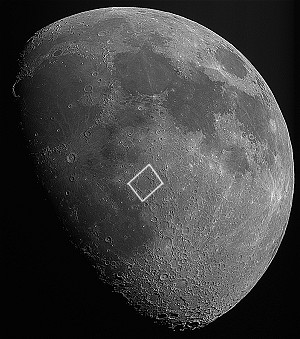This picture shows very large shadows over the floor of the crater, produced by the crater rims, which are not higher than 3kms.
Ptolemaeus is an ancient lunar impact crater. To the south-southeast Ptolemaeus is joined to the rim of the crater Alphonsus by a section of rugged, irregular terrain, and these form a prominent chain with Arzachel to the south. To the southeast is Albategnius and to the north is the smaller but well-defined Herschel.
The features of Ptolemaeus are highlighted when the Sun is at low angles during the first and last quarter. At full Moon the Sun is directly overhead and the crater contours become more difficult to discern.
The crater has a low, irregular outer rim that is heavily worn and impacted with multiple smaller craters. The rim has a discernibly polygonal shape, although overall it remains circular. The largest of the peaks along the rim, designated Ptolemaeus Gamma (γ), has an altitude of 2.9 km and is located along the northwest rim. The crater has no central peak, a lava-flooded floor, and lacks a ray system. Impact sites of this form are often classified as walled plains, due to their resemblance to the maria.
The somewhat dark-hued floor of Ptolemaeus is notable for several ghost craters, formed where lava has covered a pre-existing crater. These leave only a slight rise where the rim existed, and are difficult to detect except at low angles of sunlight, as on this picture. There are also multiple smaller craters across the floor surface, most notably Ammonius in the northeastern quadrant.
(extracted from wikipedia)
 Esta fotografía muestra sombras muy alargadas sobre el suelo del cráter, producidas por los bordes del cráter, que no superan los 3kms.
Ptolomeo es un antiguo cráter lunar de impacto. Al sur-sureste Ptolomeo se une al borde de la cráter Alphonsus por una sección de terreno accidentado e irregular, y éstas forman una cadena importante con Arzachel hacia el sur. Al sureste está Albategnius y al norte está el más pequeño, pero bien definido Herschel.
Las características de Ptolomeo se resaltan cuando el Sol está en ángulos bajos durante el primer cuarto y el último. En luna llena, el Sol está directamente encima y el contorno del cráter es más difícil de discernir.
El cráter tiene un borde bajo e irregular que está muy desgastado y ha sido impactado con varios cráteres más pequeños. El borde tiene una forma poligonal, aunque en general sigue siendo circular. El mayor de los picos a lo largo del borde, designado Ptolomeo gamma (γ), tiene una altura de 2,9 km y está situado a lo largo del borde del noroeste. El cráter no tiene pico central, un fondo inundado de lava, y carece de un sistema de rayos. Los sitios de impacto con esta forma se clasifican a menudo como llanuras con paredes, debido a su parecido con los mares.
El fondo un poco oscuro de Ptolomeo es notable por varios cráteres fantasma, formados donde la lava ha cubierto un cráter preexistente. Estos muestran sólo una ligera elevación donde estuvo el borde, y son difíciles de detectar, excepto en ángulos bajos de luz solar, como en esta imagen. Hay también varios cráteres más pequeños a través de la superficie del fondo, sobre todo Ammonius en el cuadrante noreste.
(extraído de Wikipedia)
 Type: Walled plain Geological period: Pre-Nectarian (From -4.55 billions years to -3.92 billions years) Size: Dimension: 158.0x158.0Km / 93.0x93.0Mi Description: Circular formation forming a remarkable trio with Alphonsus and Arzachel. Few steep slopes riddled by many craterlets and supporting a chain of craterlets to the North-East. High walls. Very large flat floor containing Ammonius and several ghost craters. Craterlets depressions and hills. Observation: Interest : Exceptional formation Observation period: First Quarter or 6 days after Full Moon Minimal Instrument: 10x binoculars
Position:
Longitude: 1.8° West Latitude: 9.2° South Quadrant: South-West
Area: Ptolemaeus crater region Atlas: Rukl map: 44 Ptolemaeus Viscardy page: 206 Hatfield map: 13g6 Westfall Atlas: 003C 009C 174C 179C 183C Charles Wood article: ST06/02 MM136 Lunar Orbiter: IV-101-H3 IV-108-H2 IV-108-H3 IV-108-M Name Origine: Detailed Name: Claude Ptolemee 2 nd century greek Astronomer mathematician and geographer born in Greece Born at: Ptolémaïs de Thébaïd in 90 Dead at: Canope in 170 Important Facts: Numerous works on cartographic projections and the theory of the sounds. Author of the 'Almagest' encyclopedic work in 13 books in which is developed the geocentric theory. Name Author: Riccioli (1651) Name by Langrenus: Innocentii X Name by Hevelius: Mons Sipylus Name by Riccioli: Ptolemaeus |


 Type: Walled plain
Type: Walled plain